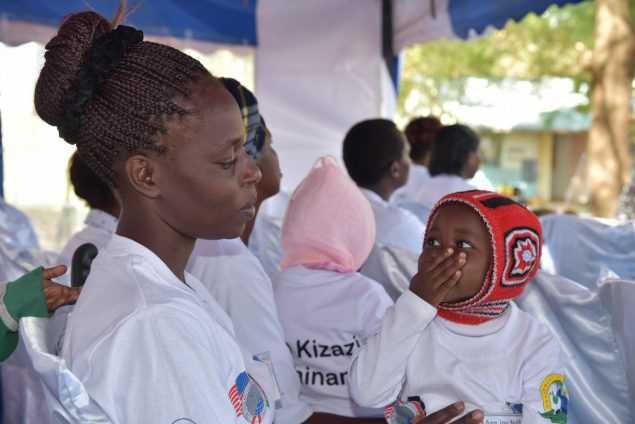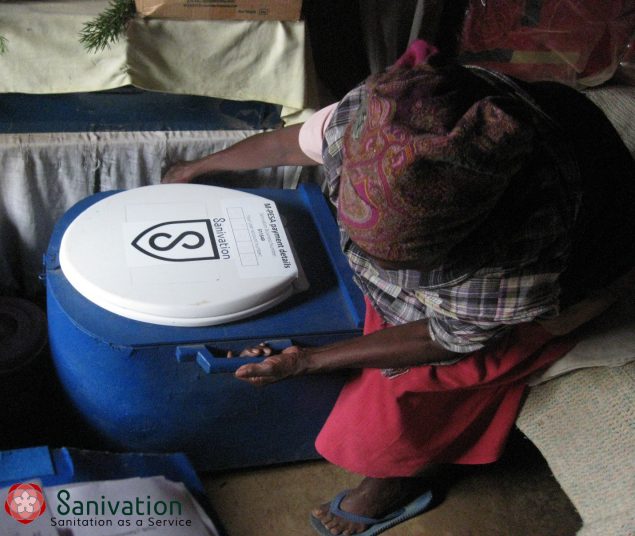Our Stories: CDC in Kenya
CDC Kenya is widely known for its impact related to science, surveillance, and service, but it is also known for its stories — those of lives impacted and transformed, such as the story of Faith. Faith is a female sex worker whose story begins with one of CDC Kenya’s cornerstone activities — science
Globally, Africa bears the greatest burden of malaria. Since 2000, malaria control efforts have led to a 62 percent reduction in deaths. Despite this achievement, an estimated 445,000 people died from malaria in 2016, the majority of them young African children. New tools are needed to fight the disease.
HIV vaccine research has had its share of difficulties. However, a new trial making its debut in sub-Saharan Africa may lead to a breakthrough. The National Institutes of Health’s antibody-mediated prevention (AMP) study, also known as HIV Vaccine Trials Network (HVTN)…
On May 5, 2017, the U.S. Ambassador to Kenya Robert F. Godec, CDC Kenya and partner organizations stood on the grounds of Magadi Primary School to launch the Child Health and Mortality Prevention Surveillance (CHAMPS) project in Kisumu and Siaya counties in western Kenya.
In 2017, Dahabo Adi Galgalo, a second year resident of the Kenya Field Epidemiology and Laboratory Training Program (FELTP) won a $100,000 Innovation Award from the Alliance for Accelerating Excellence in Science in Africa (AESA).
Following the launch of the UNAIDS 90-90-90 targets, it became clear that accurate and efficient surveillance methods are needed to monitor Kenya’s progress towards meeting those goals. HIV case-based surveillance (CBS) is more accurate than aggregate reporting in tracking these targets.
Given the recent experiences of rapidly spreading global outbreaks across borders and continents, an effective surveillance system for zoonotic diseases, which account for 60% of emerging diseases, must quickly detect and report disease events in human and animal populations to trigger timely investigation and response.
Every year, about 50,000 refugees resettle to the United States under the United States Refugee Admissions Program (USRAP). The resettlement process involves U.S government agencies including the Department of Homeland Security
Antibiotic resistance (AMR) is one of the most significant global public health problems and is rising in many countries due to over-use of antibiotics, widespread availability of counterfeit or substandard medicines and poor infection prevention and control measures.
In 2017, Kenya experienced a surge in cholera cases across the country, including urban outbreaks in the capital city, Nairobi. A total of 3,967 cases including 76 deaths were reported across 20 of 47 counties (43%) in the country.
The Detection and Response to Respiratory Events (DaRRE) project aims to identify cases of respiratory illness that could lead to outbreaks early enough in order to put prevention and control measures in place.
Three counties in western Kenya with the highest HIV burden (Homa Bay, Siaya, and Kisumu) have struggled with identifying new HIV infections. To increase HIV testing services and the detection of HIV infections, 7 high-volume health facilities in western Kenya expanded HIV testing eligibility to now include clients…
To ensure our HIV and TB implementing partners deliver high quality HIV services, PEPFAR developed the Site Improvement through Monitoring System (SIMS). Delivered through a standardized tool, SIMS site visits consist of a rapid assessment of services provided at CDC-funded health facilities. Using a 4-color scoring criteria…
Kenya celebrated World TB Day on March 24, 2017 by releasing results from the National TB Prevalence Survey. The report revealed that there are more TB cases in Kenya than previously estimated with a TB prevalence of 558 per 100,000 people and approximately one-half of all persons with TB in Kenya…
CDC Kenya works to strengthen laboratories and support diagnostic capacity, appropriate specimen-handling, quality assurance systems, and adequate biosafety standards both in Kenya and across the region.
When one thinks of health information technology (IT) — one may also think of high costs, specialized equipment and infrastructure development. However, large financial investments in health IT are not always necessary to improve clinical care efficiency.
In 2017, the Kenya FELTP continued making substantial strides through accreditation from the Training Programs in Epidemiology and Public Health Interventions Network (TEPHINET).
In 1999, CDC in collaboration with WHO launched the Stop Transmission of Polio — STOP program — to train and mobilize teams to provide technical assistance to polio-endemic countries.
“In September 2010 [I was] happily pregnant with my second born…The nurse at the antenatal clinic offered to test me for HIV and I obliged…HIV was never meant for people like me — or so I thought. Within 15 minutes my world view and status had changed, as I was declared HIV positive.”
Water, sanitation, and hygiene, commonly referred to as WASH, is essential to ensuring public health. Globally, 6 in 10 people (or 4.5 billion) lack safely managed sanitation. This puts people, especially children, at risk of diarrheal illnesses including cholera, dysentery, and typhoid fever. In Kenya, open defecation remains a major public health problem, with 95% of human fecal waste released untreated into the environment. In early 2017, the government of Kenya launched a step-up campaign to eliminate open defecation by 2020. To support this effort, CDC staff in Atlanta and Kenya are collaborating with a local nongovernmental organization, Sanivation, to improve WASH in Kenya one briquette at a time.
On April 6, 2017, CDC Kenya along with key partners celebrated the opening of the Jaramogi Oginga Odinga Teaching and Referral Hospital (JOOTRH) Wellness Center. The JOOTRH Wellness Center is one of six clinics in Kenya that have been authorized to provide medically assisted therapy (MAT) to people who inject drugs.
- World AIDS Day Pre-Event in Kenya – A Celebration of Leadership. Commitment. Impact.November 29th, 2016 11:00 am ET – U.S. CDC Kenya Office
- Kenyan FBOs Take On HIV/AIDSNovember 3rd, 2016 11:00 am ET – U.S. CDC Kenya Office
- DGHT Director, Dr. Shannon Hader Visits KenyaOctober 24, 2016 11:00 am ET – U.S. CDC Kenya Office
- New Hope in Combatting an Old Scourge – Rotavirus Vaccine in KenyaJuly 25, 2016 1:00 pm ET – U.S. CDC Kenya Office
- Rosemary’s Journey: Kenya’s First Medically Assisted Therapy Program to Reduce HIV Transmission among People Who Inject DrugsMarch 23, 2016 1:00 pm ET – U.S. CDC Kenya Office
- An AIDS-free Future: CDC Helping Young Women Achieve Their DREAMSNovember 25, 2015 1:00 pm ET – U.S. CDC Kenya Office
- CDC Working to Eliminate Mother-to Child Transmission in KenyaNovember 23, 2015 1:00 pm ET – U.S. CDC Kenya Office
- Kenya makes great strides towards Rabies EliminationNovember 3, 2015 1:00 pm ET – U.S. CDC Kenya Office
- Kenya joins the world in ‘Closing the Immunization Gap’April 27, 2015 1:00 pm ET – U.S. CDC Kenya Office
- Kenya Exceeds Goals to Address TB and HIV CoinfectionMarch 23, 2015 12:00 pm ET – U.S. CDC Kenya Office
- A Consequence of Conflict: The Spread of Multidrug-Resistant TuberculosisMarch 23, 2015 11:00 am ET – U.S. CDC Kenya Office
- Focus, Partner, Achieve: Using Evidence to Achieve an AIDS-Free Generation in KenyaNovember 18, 2014 1:00 pm ET – U.S. CDC Kenya Office
- Beginning Life Anew: An HIV Free ChildNovember 25, 2014 12:00 pm ET – U.S. CDC Kenya Office
- Giving Blood, Giving LifeJune 13, 2014 2:00 pm ET – U.S. CDC Kenya Office
- US Refugee Admissions Program: Improving Health of US-bound RefugeesApril 28, 2014 12:00 pm ET – Warren Dalal, Program Support Unit, Immigrant Refugee Migrant Health Branch, Division of Global Migration and Quarantine
- Sharing Global Health Successes and Challenges: Conference on Retroviruses and Opportunistic Infections (CROI)March 13, 2014 2:00 pm ET – U.S. CDC Kenya Office
- https://www.cdc.gov/globalhealth/countries/kenya/blog/default.htmJanuary 9, 2014 1:22 pm ET – U.S. CDC-Kenya Office
- Improving HIV Diagnosis and Linkage to Care: Point-of-Care TestsNovember 26, 2013 1:00 pm ET – U.S. CDC-Kenya Office
- Kenya’s progress towards sustainable healthOctober 21, 2013 10:48 am ET – Tom Kenyon, MD, MPH, Director, Center for Global Health
- Souda’s Story: CDC Support Benefits a Rwandan RefugeeAugust 2, 2013 11:00 am ET – U.S. CDC-Kenya Office
- Stomping Out Malaria in PregnancyApril 24, 2013, 5:00 pm ET – U.S. CDC Kenya Office
- Improving Indoor Air Quality in Rural KenyaJanuary 25, 2013, 5:00 pm ET – U.S. CDC Kenya Office
- Irene’s Story: Evidence-Based HIV Prevention Interventions Support Vulnerable ChildrenNovenber 29, 2012 3:00 pm ET – U.S. CDC-Kenya Office
- Putting Nomadic Pastoralists on the MapOctober 23, 2012 4:00 pm ET – U.S. CDC-Kenya Office
- Restoring Health for Kenyans with HIV: Komarock Clinic, NairobiOctober 2, 2012 1:00 pm ET – U.S. CDC-Kenya Office
- Our Research in Kenya: Finding Ways to Improve HIV Treatment Access and OutcomesJuly 26th, 2012 12:01 pm ET – Jane Mwangi, U.S. CDC-Kenya Office
- Today is the DayJune 20th, 2012 11:00 am ET – U.S. CDC-Kenya Office
- The Man Who Calls the Shots: Tabu CollinsApril 24th, 2012 7:24 pm ET – U.S. CDC-Kenya Office
- Solving a Malaria MysteryApril 25, 2012 5:00 pm ET – U.S. CDC-Kenya Office
- Our Work in Kenya Reflects Our Global CommitmentMarch 15, 2012, 6:00 pm ET – U.S. CDC Kenya Office
- Tuberculosis: The world cannot afford another phase of neglectFebruary 14th, 2012, 5:00 pm ET – Kevin Cain, U.S. CDC Kenya Office
- Lillian and Baby Rose: An HIV-Positive Mother Gets Help From CDCOctober 5th, 2011, 6:00 pm ET – U.S. CDC Kenya Office
- Improving the Lives of Children in KenyaAugust 29th, 2011 – U.S. CDC-Kenya Office
- A Pharmacist Motivated by Inspirational WomenAugust 9th, 2011 4:43 pm ET – U.S. CDC Kenya Office
- A Promising New Career in the Slums of KiberaAugust 9th, 2011 2:28 pm ET – U.S. CDC Kenya Office
- The Snowball Effect—Battling Malaria on a Global StageJune 22nd, 2011 – U.S. CDC-Kenya Office
- Improving Health for Kenya’s Refugees by Building Laboratory CapacityMarch 9th, 2011 – U.S. CDC-Kenya Office
- One Woman, One Community, Many GainsMarch 1st, 2011 – U.S. CDC-Kenya Office













